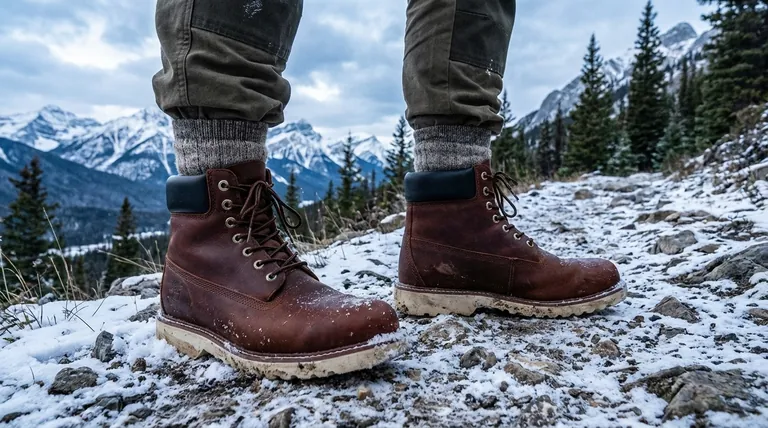The fundamental trade-off between leather and fabric boots comes down to a choice between warmth and breathability. Leather boots are significantly warmer but less breathable, while fabric boots offer superior breathability at the cost of insulation. For boots that feature a Gore-Tex liner, the outer material does not determine its waterproofness; that function is handled by the internal membrane itself.
Your choice of boot material is not about which is universally "better," but about aligning the specific properties of leather or fabric with the environment and activity level you anticipate.

The Core Trade-off: Warmth vs. Breathability
The material on the outside of your boot directly dictates how it manages heat and moisture created by your feet. This is the most important factor in your decision.
Leather: The Case for Insulation
Leather is a natural material that provides significant insulation. Its dense structure is excellent at trapping air, which in turn keeps your feet warm in cold conditions.
This makes leather an ideal choice for winter hiking, cold-weather work, or any situation where retaining heat is a priority.
Fabric: The Case for Ventilation
Synthetic fabrics, such as nylon and polyester meshes, are engineered for high breathability. They allow heat and water vapor (sweat) to escape from the boot much more efficiently than leather.
This ventilation is critical during high-exertion activities or in warm climates, as it helps prevent your feet from overheating and becoming clammy, which can lead to blisters and discomfort.
Debunking a Common Myth: Waterproofing
Many people assume leather is inherently more waterproof than fabric. When dealing with modern technical boots, this is often a misconception.
The Role of the Gore-Tex Liner
In most high-quality hiking and tactical boots, waterproofing is achieved with an internal waterproof-breathable membrane, like Gore-Tex.
This membrane is a barrier that stops liquid water from getting in while allowing water vapor from sweat to get out. The boot's outer material—whether leather or fabric—serves primarily to protect this delicate inner liner.
Why the Outer Material Still Matters
While the liner provides the waterproofing, the outer material provides the boot's structure and durability.
A full-grain leather exterior is exceptionally tough and abrasion-resistant. A fabric exterior is typically lighter and may dry faster if the surface becomes saturated.
Understanding the Trade-offs in Practice
How these material properties translate to real-world performance depends entirely on your specific use case.
Fit and Comfort
Regardless of material, a proper fit is paramount. Leather boots often require a longer break-in period but can mold to the specific shape of your foot over time, providing a custom-like fit.
Fabric boots tend to be more flexible and comfortable right out of the box but may not offer the same long-term molded support. Always try on different sizes to find the best fit for your foot.
Durability and Maintenance
Leather is renowned for its long-term durability but requires periodic cleaning and conditioning to prevent it from drying out and cracking.
Fabric boots are generally easier to care for but may be more susceptible to tears and abrasion from sharp rocks or dense brush compared to high-quality leather.
Making the Right Choice for Your Needs
Base your decision on the conditions you will most frequently encounter.
- If your primary focus is cold-weather use or low-exertion activities: Choose leather for its superior insulation and ability to keep your feet warm.
- If your primary focus is warm-weather hiking or high-exertion activities: Choose fabric for its crucial breathability, which will keep your feet drier and more comfortable.
- If your primary focus is maximum durability for rugged, off-trail use: A heavy-duty leather boot often provides the best protection against abrasion.
Ultimately, selecting the right boot means honestly assessing your needs and choosing the material whose strengths are best suited to your mission.
Summary Table:
| Feature | Leather Boots | Fabric Boots |
|---|---|---|
| Primary Strength | Superior Warmth & Insulation | Superior Breathability & Ventilation |
| Ideal For | Cold weather, low-exertion activities | Warm weather, high-exertion activities |
| Durability | High abrasion resistance, long-lasting | Lighter weight, may be less abrasion-resistant |
| Break-in & Comfort | Longer break-in, molds to foot over time | More flexible, comfortable out-of-the-box |
| Waterproofing | Dependent on internal membrane (e.g., Gore-Tex) | Dependent on internal membrane (e.g., Gore-Tex) |
Ready to Source the Perfect Boots for Your Market?
As a large-scale manufacturer, 3515 produces a comprehensive range of footwear for distributors, brand owners, and bulk clients. Our production capabilities encompass all types of leather and fabric boots, including tactical, hiking, and work styles.
Let us help you make the right material choice for your target customers and climate. We offer OEM/ODM services to bring your specific boot designs to life with consistent quality and competitive pricing.
Contact our expert team today to discuss your manufacturing needs and request a quote.
Visual Guide

Related Products
- Wholesale Leather Work Boots with Customizable Wedge Sole for Brands
- Durable Leather Work Boots Wholesale Manufacturer & Custom Factory
- Durable Leather Tactical Boots Wholesale & Custom Manufacturing for Brands
- Durable Leather Work Boots for Wholesale & Custom Manufacturing
- Durable Leather High-Ankle Tactical Boots for Wholesale & Custom Manufacturing
People Also Ask
- What type of boots are suitable for challenging weather conditions in a business setting? | Durable & Professional Footwear
- How can the flexibility of leather work boots be maximized? Achieve Lasting Comfort & Performance
- What are the advantages of leather uppers in work boots? Unmatched Durability & Protection
- How does cleaning your work boots help in their maintenance? Extend Lifespan & Boost Safety
- What maintenance tips are recommended for leather safety footwear? Extend Lifespan & Preserve Safety



















